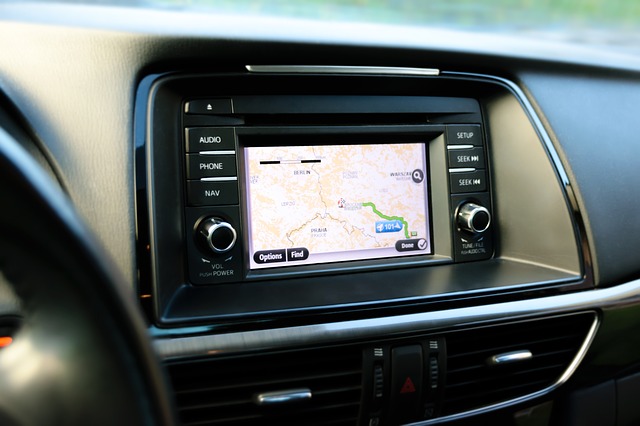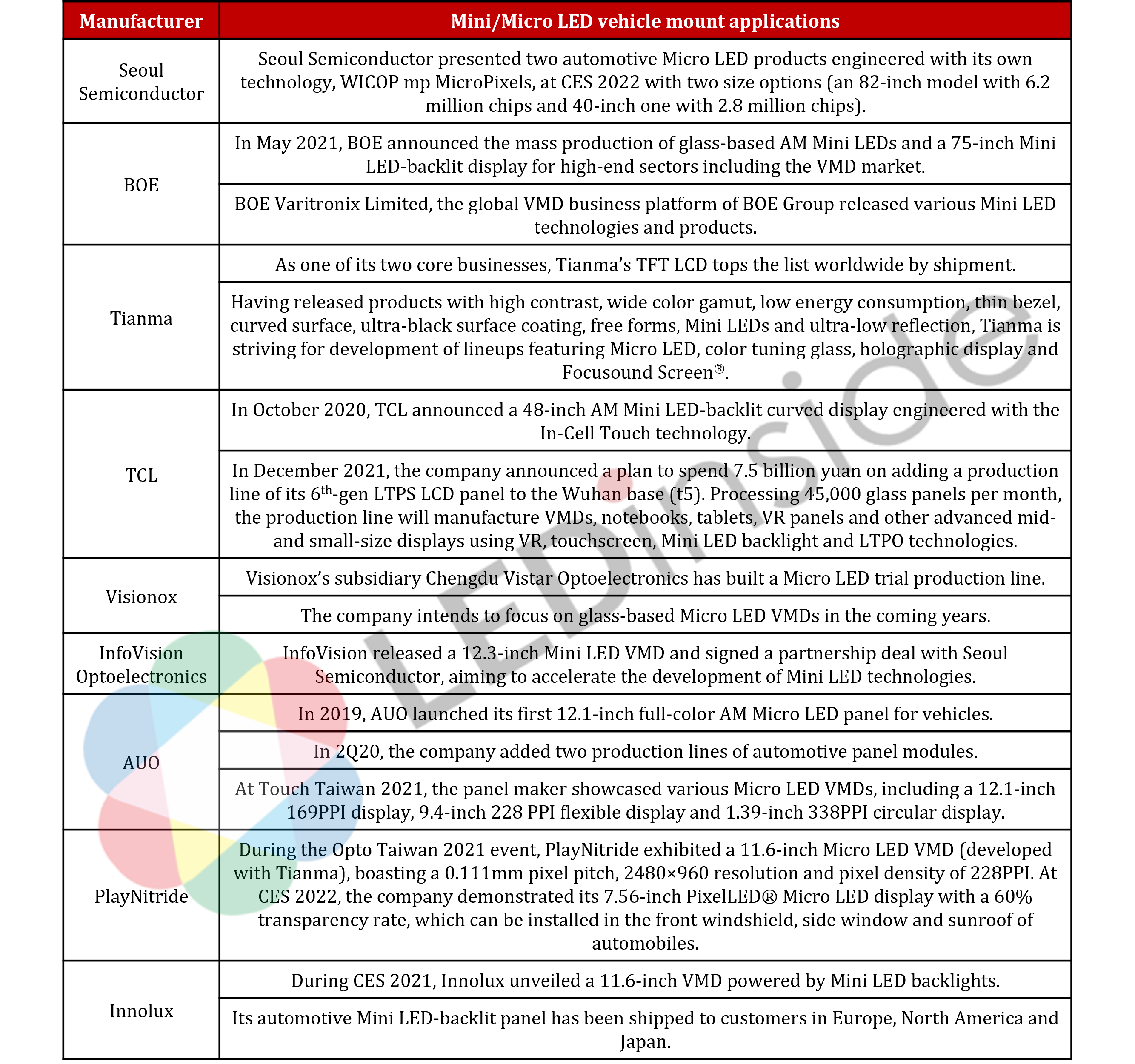Car design is on the verge of a revolution.

There are four major trends in the automotive industry, namely electrification, internet connection, smartification and car sharing, where car makers will try to electrify vehicles and connect them to the internet for big data analytics and ultimately create lifestyles with smart driving and car sharing. Under such circumstances, people will start to realize that cars have transitioned from being merely a transportation tool to a fancy digital product.
Meanwhile, vehicle mount displays (VMDs)—as a major demonstration of human-vehicle interaction and state-of-the-art and technology-focused interior designs—are heading toward the use of large, multiple displays with high resolution, low energy consumption, and high interaction levels in various forms. The VMD market has thus become the fifth largest panel market following the smartphone, tablet, notebook and monitor sectors.
However, a consensus has yet to be reached on which technological solutions are favorable for VMDs.
LCD is Trending Now, but Which Technology Will Dominate the Future?
As LCD technology is relatively mature, a comprehensive standardized system has been established for the sector with high quality products, sufficient production capacity and a strong cost advantage. Thus, LCD is currently the major technology for VMDs.
However, when the aforementioned four automotive trends emerge, LCD will fail to meet the requirements of high-end automotive display systems due to inadequate brightness output, faster temperature rise and limited visual effects. Under such circumstances, OLED, Mini LED and Micro LED—with increasingly clear technological advantages—are expected to dominate the VMD market for years to come.
The three technologies have their own strengths and weaknesses. OLED, an organic self-luminous component, is known for excellent display effects, low energy consumption, high flexibility and ultra-thinness, which has been applied to high-end vehicles. For example, Mercedes Benz has replaced the original integrated center console screen with a 12.8-inch OLED vertical waterfall panel for its 2021 S Class models. Specifically, its electric vehicle EQS comes with a pillar-to-pillar large, flexible OLED touchscreen under a single surface (i.e., MBUX Hyperscreen).
OLED VMDs are mainly provided by Samsung, LGDisplay and BOE. However, problems of screen burn-in—a major issue for OLED displays despite years of development—as well as the short lifespan of most OLED blue lights have impeded further advances of the technology in the VMD sector.
Mini LED technology can be combined with flexible substrates to realize curved display design with enhanced brightness and contrast, thereby adding flexibility to in-cabin screen design. Nevertheless, compared with its OLED counterparts, Mini LED displays tend to be thicker with limited bendability.
Notably, Mini LED backlight, rather than Mini LED direct view, is preferable for VMDs. This is mainly because the direct view technology tends to create a greater pixel pitch, resulting in excessively visible pixels when the monitor is used in the car (where the viewing distance is short).
Micro LED display is a miniaturized matrix LED technology, which has greater advantages in various aspects including brightness, resolution, contrast, energy consumption, lifespan, response rate and thermal stability. However, this advanced technology has yet to reach the mass production level due to considerable technical difficulties, a low yield rate and high costs.
Compared with other displays, VMDs have higher standards of display-related technologies as they must have high brightness, a long lifespan, short response time and a wide temperature range. OLED, Mini LED-backlit and Micro LED monitors all have their limitations, but OLED is currently the most prevalent and mature in the VMD market. Conversely, Mini LED backlight and Micro LED are still at the introduction stage, where there is a greater room for improvement regarding product performance and production cost. Nevertheless, the two promising technologies have become “high-profile choices” for VMDs in the future with high expectations from investors and businesses.
Mini LED backlight and Micro LED Are Making Progress, in Small but Quick Steps
Recently, there has been some noticeable progress in the development of automotive Mini LED backlight and Micro LED technologies. LEDinside has briefly summarized the statuses of the leading suppliers of automotive Mini LED backlights and Micro LEDs in the table below.


The table shows that both multinational and Chinese companies as well as panel and conventional LED makers have strived for the development of automotive Mini LED-backlit and Micro LED technologies and products.
Additionally, businesses in relevant supply chains have established partnerships to jointly overcome enormous technical difficulties.
In December 2021, Tianma held the 2021 Micro LED Eco-Alliance Conference, during which it formed an alliance with upstream suppliers, downstream automakers and university research institutes, aiming at relevant VMD applications. The display manufacturer also unveiled various Micro LED products on site, including a foldable monitor with a diameter of 5 mm, a screen with a 70% transparency rate, a Micro LED-tiled monitor and a high-resolution VMD.
Furthermore, Tianma established a close partnership with PlayNitride. In 2019, Tianma showcased a 7.56-inch AM Micro LED display with a >60% transparency rate at the SID Display Week symposium. At Opto Taiwan 2021, PlayNitride demonstrated a 11.6-inch automotive Micro LED monitor. The two products were jointly developed by the two manufacturers.
PlayNitride also partnered with AUO in April 2020 by launching the research and development of Micro LED display technologies. In December 2020, the display maker signed a 4-year partnership deal with the Industrial Technology Research Institute in Taiwan, focusing on Micro LED applications such as AR and MR devices and vehicle mount panels.
In April 2021, Longli Technology cooperated with Wuhan TCL to establish a joint innovation laboratory targeting at mid- and small-size display technologies. The laboratory is dedicated to research and development of cutting-edge technologies in the backlight display industry, particularly Mini LED; their applications include displays for smartphones, tablets, notebooks, VMDs and VR and AR wearables.
In 2019, BOE, another major panel maker, founded a joint venture BOEPixey with Rohinni, aiming to develop Micro LED solutions for display backlights; its initial target markets include large consumer electronics (≥ 32 inches) as well as industrial and automotive sectors.
Conclusion
To Mini/Micro LED businesses, the VMD market is worth a fight—despite its niche applications that require more time to be verified—because of the display’s long life cycle, technology-intensive nature and high profit rate.
However, Micro LED remains a challenging technology where no one has succeeded in mass producing Micro LEDs, whereas Mini LED products have already become state of the art. For example, the ET7, a 10.2-inch HDR dashboard released by BOE in January 2021, is composed of Mini LED backlights.
Additionally, Mini LED displays can be installed in the exterior, making the appearance of cars more fancy. In November 2021, the Chinese carmaker Great Wall Motor announced its first saloon model, the Mecha Dragon; the model comes with smart taillights and a Mini LED exterior screen, on which drivers can display whatever content they want.
The VMD market is a key that enables Mini/Micro LED to take off. After such cutting-edge technologies, particularly Micro LED, overcome the existing challenges, they will definitely be strong enough to compete with OLED in the automotive display sector.
(By Lynn from LEDinside; credit of first image: pixabay)





 CN
TW
EN
CN
TW
EN








